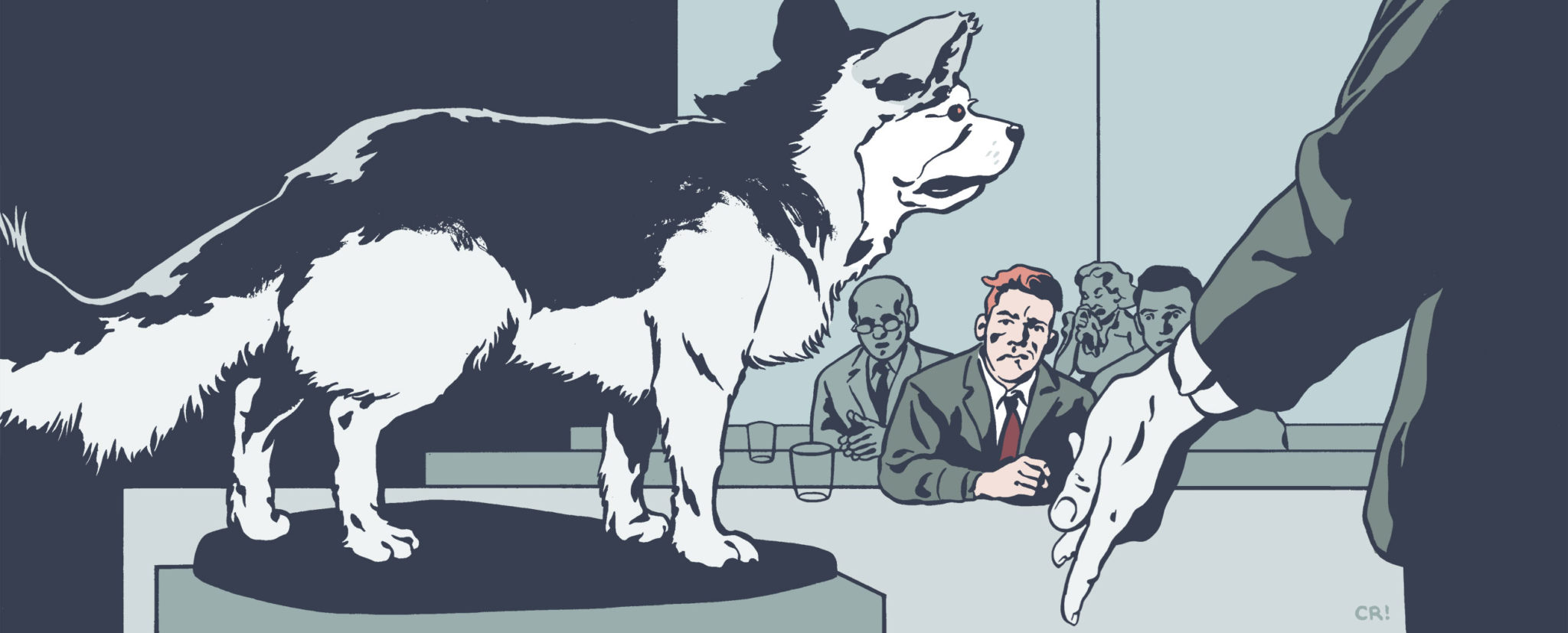
Illustrations by Casey Roonan.
It was drizzling on the night Pretoria McPhail, a homeless woman, sought refuge inside an unlocked taxi parked near the Southport Esplanade, an hour’s drive south of Brisbane, Australia. Her dog, Boots, had started barking at a tall, thin man in a hat and overcoat who was striding past, his own dog trailing behind him. As she stumbled into the back seat of the cab, Boots’ barking intensified. McPhail later told The Truth newspaper that she had been overcome by a feeling of “cold and inexplicable horror ” as she scrambled out again and set off on foot to find somewhere else to sleep.
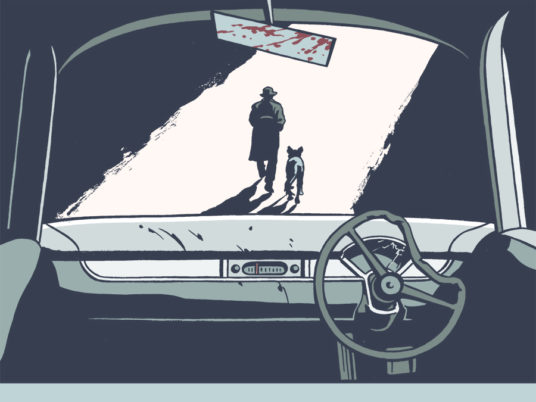
Hours later — shortly after 7 a.m. on May 23, 1952 — a fisherman known as Bob Dingo came upon the same taxicab. It looked out of place, under a fig tree in a “No Parking” zone. Dingo propped his rod against the tree and went to investigate. The daylight revealed what McPhail had missed in the dark: The interior of the cab was splattered with blood, brain matter and human hair.
Southport Police turned up soon after Dingo’s panicked phone call. The indentations in the dashboard and upholstery suggested that the driver had been bludgeoned with a metal object, perhaps a wrench. Police quickly established who had been driving the taxi the night before: Athol McCowan, a 24-year-old bachelor who lived with his parents and had been discharged from the army four years earlier. He hadn’t come home after his work shift that night.

The Brisbane Telegraph reported the discoveruy of the blood-stained taxi and suspected murder of Athol McCowan. Photos courtesy of the Queensland Police Museum.
Police set about tracing McCowan’s last known movements. Under the direction of Detective Inspector Frank “The Big Fella” Bischof, a burly Brisbane policeman, they interviewed dozens of witnesses, according to Ken Blanch in his book Slim Halliday: The Taxi Driver Killer. A trucker had seen the taxi parked at a coastal lookout on Currumbin Hill at about 10 p.m. on the night in question. Two others watched it make a detour into an RV park at 10:30 p.m. A colleague of McCowan’s saw the taxi traveling north at a fair clip soon after that, but he didn’t think McCowan was behind the wheel. Police tracked down everyone who’d taken a ride in the taxi that night — all except one: the final, fatal fare.
Finding McCowan’s body was crucial, but the search area was huge. Back then, the Gold Coast south of Brisbane wasn’t the high-rise metropolis it is today, but rather a collection of sleepy towns strung together by a narrow bitumen road. On one side lay the endless Pacific Ocean, fed by creeks and rivers; on the other, a tangle of rainforest.

McCowan in his army uniform.
The people of Southport and neighboring towns were shocked. Crimes like this were unheard of in that part of the country. Detectives were overwhelmed with offers of support from the community. As they searched the bush and foreshores, underwater spear fishermen plumbed the waterways, beach lifeguards ventured out in boats, army aircraft surveyed the coastline, and civilians fanned out across beaches and backyards. Police cadets cleared vegetation with scythes and reaping hooks and dragged waterways with a giant magnet in the hope of finding the murder weapon.
It would be another week before McCowan’s body washed up on a sandbank near Cribb Island, north of Brisbane, at low tide. His body, fully clothed, was lying face down, arms and legs spread-eagled, wristwatch and wallet missing. Strong ocean currents had carried the body more than 60 miles north. A postmortem reported in the Queensland Police Gazette on June 7, 1952, noted the cause of death as injuries to the brain and multiple fractures of the skull.
* * *
Police now had a body, but not a suspect. Frustrations mounted as two drifters were detained, questioned and released. Then a young detective constable got a tip about a man named Fred Dale. A witness reported that Dale had been working in Southport in his utility truck at the time of the murder. He’d shot through to Sydney the morning after the murder, then reappeared in Brisbane, looking nervous in new clothes, the day before the body was found.
Fred Dale, it turned out, was an alias. The suspect’s real name was Arthur Ernest Halliday, known by the sobriquet of “Slim” due to his tall, skeletal frame. Slim Halliday was one of Australia’s most notorious criminals. Since leaving an orphanage at the age of 15, he’d worked a series of odd jobs — sheepshearer, farmhand, plumber — but a history of housebreaking, stealing cars and writing dud checks meant he’d been in and out of prison since 1936. Halliday had become known as “Australia’s slipperiest prisoner” thanks to his talent for escaping. Authorities complained that he could “climb walls like a fly.” In 1940, and later in 1946, Halliday rappelled up and over a 25-foot-high wall in the corner of His Majesty’s Prison, a high-security facility also known as Boggo Road Gaol, The Sunday Mail reported. The prison was closed in 1992 and has since reopened as a tourist attraction, where visitors can view the stretch of wall dubbed “Halliday’s Leap” for themselves.
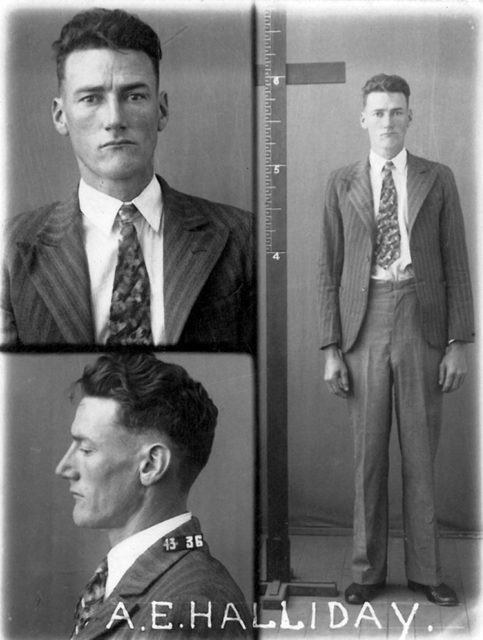
Mugshots of Arthur Ernest “Slim” Halliday.
Upon leaving prison on June 1, 1949, Halliday tried to go straight. He started his own roof repair business in Brisbane and, on January 2, 1951, at age 40, married Irene Kathleen Close, a woman described in police memos as “practically a common prostitute.”
It was a rocky relationship from the start. Halliday was restless, chasing work from here to there, and the couple moved frequently. They left one apartment in the seaside village of Redcliffe because neighbors complained about the howling of Halliday’s dog. On May 20, 1952, two days before McCowan disappeared, Close threw her wedding ring back at Halliday after a blazing fight. She was sick of this itinerant life, of struggling to make ends meet. She wanted more stability.
Police learned all this from people who knew Halliday. Investigators also found multiple witnesses who’d seen him and his dog in Southport around the time of the murder. They made a memorable pair: the tall, thin man and the bright-eyed black-and-tan bitzer (“bits o’ this, bits o’ that”) who answered to the name Peter. Some people described Peter as a crossbred Alsatian, also known as a German shepherd. Others were convinced that Peter was a kelpie — an Australian breed of working dog used to muster sheep. Whatever his genetics, Peter was loyal, affectionate and intelligent. He would regularly scale ladders to reach the roof where his master was working.
* * *
But since the discovery of McCowan’s body, Halliday was nowhere to be found. Police turned up on the doorstep of his estranged wife, who’d moved back into her mother’s house in the Brisbane suburbs. Both women provided inconsistent and outlandish accounts of Halliday’s movements. He’d gone out west seeking farm work. He’d sent a telegram from the small inland town of Surat. On it went. Their accounts only heightened police suspicions that Halliday was involved in McCowan’s murder. On one visit to Close’s mother’s house, they noticed a dog matching Peter’s description in the backyard. The animal was placed under discreet surveillance while Detective Inspector Bischof put out a nationwide alert for Halliday.
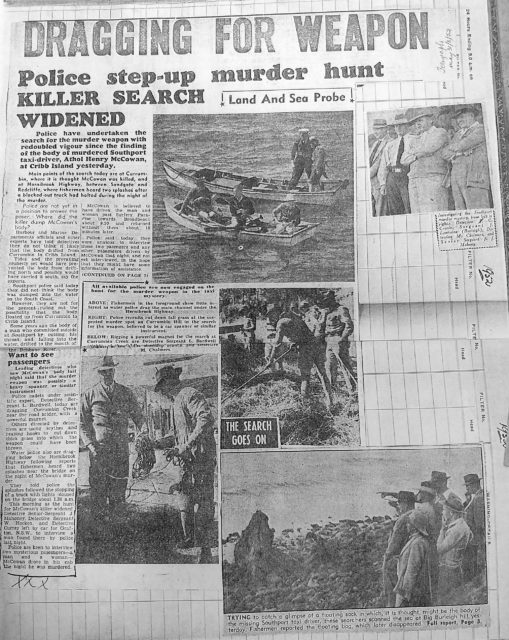
A Brisbane Telegraph reports on the search for the killer and for McCowan’s body.
The trail turned from cool to red hot on June 29, 1952, when Halliday was arrested near Parramatta, on the outskirts of Sydney, for the attempted armed holdup of a store. The shopkeeper fought back and, during the melee, a pistol Halliday was carrying went off three times. Halliday was shot in the leg, the bullet piercing his bone. Detectives flew to Sydney to interview him at the hospital. Depending on whom you believe, Halliday either made a full confession or denied everything.
Meanwhile, detectives staking out the dog noticed that it had begun to walk unsteadily. They followed one of his de facto caretakers as she took him to the vet. They subsequently learned that the vet had removed an infestation of paralysis ticks, or Ixodes holocyclus, from Peter. Paralysis ticks are found all along Australia’s east coast. Native animals like bandicoots, kangaroos, koalas and possums are generally immune to their poison. But domestic animals, including dogs, are more vulnerable. Once bitten, they may suffer breathing difficulties, weakened limbs and even death.
Indeed, the vet’s intervention could not save Peter. He died and was buried in the backyard at Close’s mother’s house. Yet, as The Courier-Mail reported, the police force realized that multiple witnesses had seen Peter and Halliday together near the crime scene around the time of the murder. On August 18, 1952, Peter’s body was exhumed by the same police officers who’d kept him under surveillance.
The following day, Queensland Police Commissioner John Smith submitted a formal request for funding to “[have] the skin and carcass of a black and fawn colored kelpie sized dog mounted for production as an exhibit in connection with the murder of Athol McCowan.”
It was one of the more unusual requests the Queensland Museum had ever received from law enforcement authorities. Don Vernon, who worked for the museum for 36 years, was the taxidermist tasked with preparing Peter for his role in court.
The museum has no records documenting Peter’s preservation. However, Dean Smith of Museums Victoria, who recently preserved an explosives detection dog for display at the Australian War Memorial, said it would have been a painstaking process that likely took around two weeks. Peter would have been skinned, using surgical-grade equipment, before his skin, with fur still attached, was tanned. According to Queensland Museum staff, Vernon would most likely have used arsenic soap, as was the practice back then. A replica of Peter’s body would have been made using something like plaster, then the skin glued back over it, before the original teeth and claws, and painted glass eyes, were added. On September 9, 1952, police took the completed reproduction back from Vernon, and Peter was put aside to await the trial.
* * *
On December 9, 1952, a pretrial hearing in Halliday’s case commenced in Southport. Spectators jostled for position, crowding the court’s verandas, doorways and open windows. At one point in the proceedings, a “mystery box” was wheeled into the courtroom. Detectives opened it with a flourish to reveal the skinned, stuffed and very lifelike Peter.
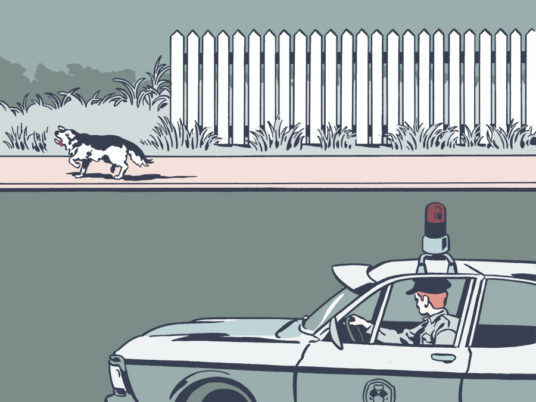
Despite his predicament, Halliday grinned at his dog from the dock. Halliday’s wife, however, burst into tears and had to be comforted by a woman sitting next to her. One by one, a procession of witnesses was brought in, linking the defendant and his dog to the scene of the crime.
During the hearing, Detective Investigator Bischof testified that Halliday had admitted to killing the taxi driver for a mere “two quid.” Halliday sprang to his feet and, leaning over the dock rail, shouted, “That’s a lie!” But police were adamant that Halliday had confessed, and in some detail. He had made McCowan stop on Currumbin Hill by telling him he needed to “take a leak.” Then, he jammed a pistol — the same pistol he later menaced the shopkeeper with — into McCowan’s ribs and demanded money. When McCowan tried to flee, Halliday bludgeoned him to death and dumped his body in a nearby creek. He then drove the bloodied taxi north, to the Southport Esplanade. As he strode toward his own vehicle, he set Pretoria McPhail’s dog into a frenzy of barking.
Halliday’s criminal trial began in Brisbane’s Supreme Court on February 23, 1953. Just over a week later, a verdict of guilty was returned, and Halliday was sentenced to life imprisonment, entering his loathed Boggo Road Gaol for the last time.
Peter also went to a prison of sorts. For the next 24 years, he was confined to a box in a storeroom, and brought out occasionally for police exhibitions. But in 1977, the Queensland Police Museum opened, and Peter’s second life began. A favorite among curators and visitors, Peter took his place alongside other exhibits documenting the state’s criminal history.
Despite being quietly paroled the year before Peter went on formal display, Halliday never saw his dog again. After his release, he slipped north to the town of Kilcoy, where he was photographed prospecting for gold in the company of another dog, Pat. Halliday died in 1987.
Peter was destined to live on, but not without incident. In 2011, according to Queensland Police Museum curator Lisa Jones, he was loaned to the Museum of Brisbane for a one-off Cabinet of Curiosities exhibition. While being transferred from the front steps to the van, a furious gust of wind lifted some tufts of fur. Closer examination revealed that Peter’s stitching was coming undone, and he was infested with moths. Following a series of repairs and some tender loving care, Peter was returned to the Queensland Police Museum. He remains there to this day — standing alert, an expectant expression on his face, as though waiting to greet his master.

Peter the dog on display at the Queensland Police Museum.
Denise Cullen is a Brisbane-based prison psychologist who writes about true crime and travel when she’s not working behind bars.